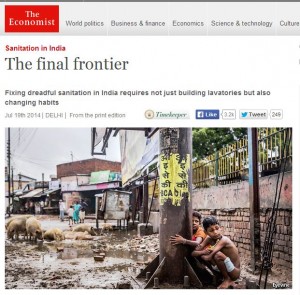ECONOMIST ARTICLE:
Fixing dreadful sanitation in India requires not just building lavatories but also changing habits
In this article it is claimed that Hinduism and Hindu culture is the root cause behind the open air defecation in India. Can they show any proof for “Laws Of Manu” where they ridiculously claim it is written encouraging open air defecation. I have not seen anywhere evidence to this effect. If Hindu culture is to blame, then how can Economist explain the fact that they themselves have alluded to that open air defection is far more in the North than in the South of India. If it were Hindu culture to blame, then the statistics regarding open air defecation should be the same in both the North and South India. Bear in mind that, the
state referred to in the article with the maximum amount of open air defecation ie. Uttar Pradesh has been ruled for years by pro-Muslim governments of Mulayam Singh Yadav and now his successor, ie. his son, Akhilesh Yadav. These two individuals are single handedly responsible for the unsanitary and rape culture that is prevalent in Uttar Pradesh today.
These two practice a policy of Muslim and Yadav appeasement and promote unsanitary living conditions among the poor and downtrodden Hindus of UP and promote rapes by Yadav and Muslim men against poor and downtrodden Hindu women folks. This is the sole reason for the unsanitary conditions prevalent among the rural, downtrodden, poor people of Uttar Pradesh. It is a tragedy that ancient Hindu scripts and culture are being blamed for what is a political issue. I would advice the Economist magazine to do proper research and not rely on hearsay to promote such unfactual information based on lies and propaganda. This is clear case of confusing bigotry for poetic justice and not having any understanding of the fact that Hinduism is a toolbox not a Bible.
And to quote from the “Huffington Post” below:
The “Ancient Hindu text” that the article refers to, the Manu Smriti, was written in 500 BCE–latrines were not exactly outfitted That text gives exacting guidelines as to the distance to be maintained from a water source such as a river while urinating or defecating. There are several rules regarding the direction to look, and how to clean oneself after defecation. The essence of the rules are the same: defecate in the open, well away from home and water sources.
Hindu texts classified as Smritis, such as the Manu Smriti referred to here, are not considered among the eternal, realized (revealed) texts classified as Sruti. So Smritis are interpretable to time and space, and to make an incredible claim that this text is guiding Hindus in how to defecate today, without any surveys or interviews given as evidence, seems wildly irresponsible. Moreover, why even invoke religion in this piece? Getting to 40 percent open defecation (the Muslim rate in the study) from 66 percent (the Hindu rate) would be a major improvement, and getting infant mortality from 75 births per 1000 to 65 per 1000 would also be a major improvement (if misleadingly presented on a graph with truncated axes). But getting to 3 percent as in Bangladesh will require making significant strides in all religious groups.
The final frontier
Fixing dreadful sanitation in India requires not just building lavatories but also changing habits
| DELHI | From the print edition
- CHEER any Indian leader who takes on the taboo of public hygiene, one of the country’s great problems. Narendra Modi, India’s prime minister, says building toilets is a priority over temples. His finance minister, Arun Jaitley, used this month’s budget to set a goal of ending defecating in the open by 2019. That will be 150 years since the birth of Mohandas Gandhi, who said good sanitation was more important than independence.
Ending open defecation would bring immense benefits. Some 130m households lack toilets. More than 72% of rural people relieve themselves behind bushes, in fields or by roadsides. The share is barely shrinking. Of the 1 billion people in the world who have no toilet, India accounts for nearly 600m.
In this section
- The final frontier
- Not quite so invincible
- The vision thing
- The pink and the pulp
- Axed
- Jittery neighbours
Related topics
The costs are high. Public safety is one underappreciated problem, as young women have to leave their rural homes after dark. In May two teenage girls in Uttar Pradesh visiting a field used as a communal toilet were raped, murdered and strung up from a tree. That case won notoriety for its extreme barbarity, but similar attacks are distressingly common.
A broader matter is public health. Open defecation is disastrous when practised by groups in close contact with each other. Because India’s population is huge, growing rapidly and densely settled, it is impossible even in rural areas to keep human faeces from crops, wells, food and children’s hands. Ingested bacteria and worms spread diseases, especially of the intestine. They cause enteropathy, a chronic illness that prevents the body from absorbing calories and nutrients. That helps to explain why, in spite of rising incomes and better diets, rates of child malnourishment in India do not improve faster. Unicef, the UN’s agency for children, estimates that nearly one-half of Indian children remain malnourished.
Hundreds of thousands of them die from preventable conditions each year, especially in the north, which has most of the open defecation (see map). Faeces in groundwater spread diseases such as encephalitis, an annual post-monsoon scourge in eastern Uttar Pradesh. Diarrhoea leaves Indians’ bodies smaller on average than those of people in poorer countries where people eat fewer calories, notably in Africa. Underweight mothers produce stunted babies prone to sickness who may fail to develop to their full cognitive potential. Dean Spears, a Delhi-based economist, says the costs of all this, in incomes and taxes forfeited, are far greater than the price of fixing it.
How to do so? India fares worse on sanitation than a host of poorer places including Afghanistan, Burundi and Congo, partly because too many of its leaders are too squeamish to face up to the issue. Thankfully, that appears now to be changing. The government, gung-ho for infrastructure, has just said it will build 5.2m toilets by September, or one every second.
Pouring concrete will not in itself solve India’s problems. Leaders need also to confront the cultural reasons for bad sanitation. Hindu tradition, seen for example in the “Laws of Manu”, a Hindu text some 2,000 years old, encourages defecation in the open, far from home, to avoid ritual impurity. Caste division is another factor, as by tradition it was only the lowliest in society, “untouchables” (now Dalits), who cleared human waste. Many people, notably in the Hindu-dominated Gangetic plains, today still show a preference for going in the open—even if they have latrines at home.
Evidence is growing that India must urgently correct its cultural practices, though it is sensitive to say so. Studies of India’s population show how since at least the 1960s child mortality rates have consistently been higher in Hindu families than Muslim ones—though Muslims typically are poorer, less educated and have less access to clean water. Today, out of every 100 children, 1.7 more Muslim than Hindu ones survive to five years, a big gap.
Mr Spears and his colleagues argue that this can be explained only by differences in sanitation habits. A 2005 government survey, the most recent national one, found that 67% of all Hindu households, rural and urban, practised open defecation, compared with just 42% of Muslim ones. (In rare places where there is more open defecation among Muslims than Hindus, the mortality gap is reversed.)
A new household survey of nearly 23,000 north Indians offers more evidence, especially from Hindu households. Led by Diane Coffey, an economist at Princeton, it found that even among households with a working latrine, more than 40% reported that at least one family member preferred to defecate in the open. Those with a government-built toilet were especially likely to choose a bush instead.
In an unpublished parallel survey of Hindu-dominated villages in north India and Nepal, respondents lauded open defecation as wholesome, healthy and social. By contrast, latrines were seen as potentially impure, especially if near the home. Men often described them as for use only by women, the infirm and the elderly. In short, demand for latrines is constrained.
This suggests that the mere availability of government-built latrines will not end open defecation for decades yet. What is needed instead are public campaigns, in schools and in the media, to explain the health and economic benefits of using toilets and of better hygiene. Researchers found that only a quarter of rural householders understood that washing hands helps prevent diarrhoea.
Such campaigns not only mean government-built latrines have a better chance of being used; they would also encourage households to build them for themselves. Precisely how to raise awareness about a touchy subject is not clear, but some at least are trying. A catchy animated music video put out by Unicef urges Indians to “take the poo to the loo”. The intention is right, even if the dancing turds will not immediately be to everyone’s taste.
Source: Sanjay Poduval Via. WHN Publisher E-mail
_____________________________________________________________________________________________________________________________________________________
Disclaimer: The opinions expressed within this article are the personal opinions of the author. World Hindu News is not responsible for the accuracy, completeness, suitability, or validity of any information on this article. All information is provided on an as-is basis. The information, facts or opinions appearing in the article do not reflect the views of World Hindu News and World Hindu News does not assume any responsibility or liability for the same.







